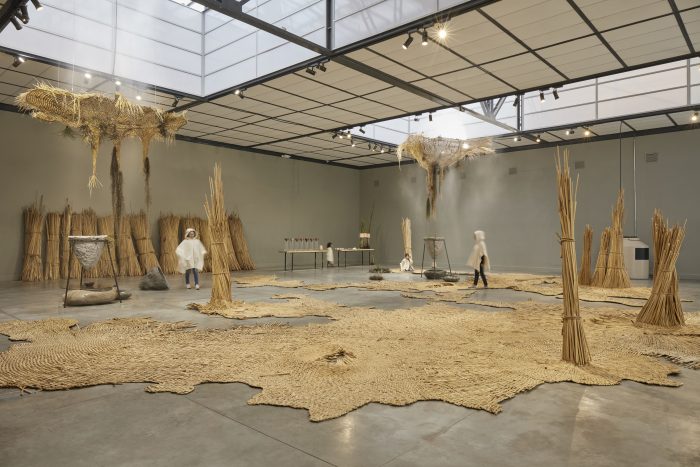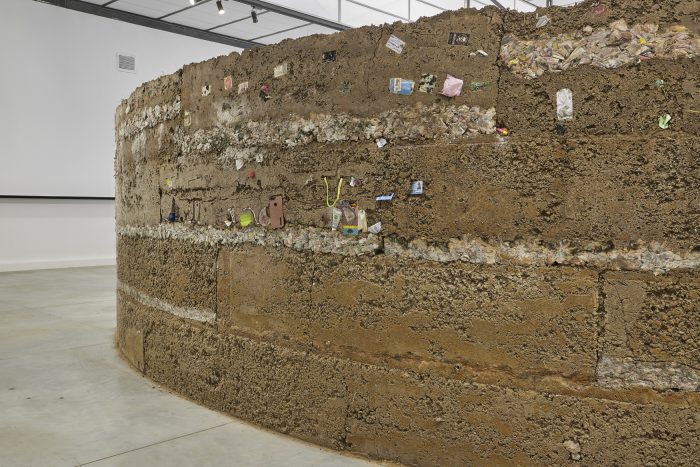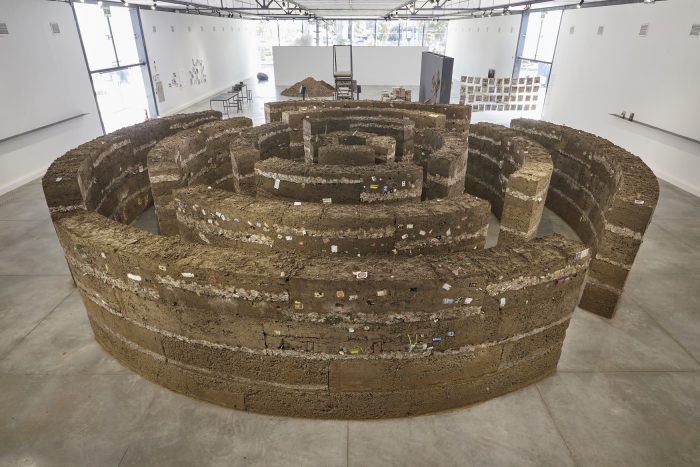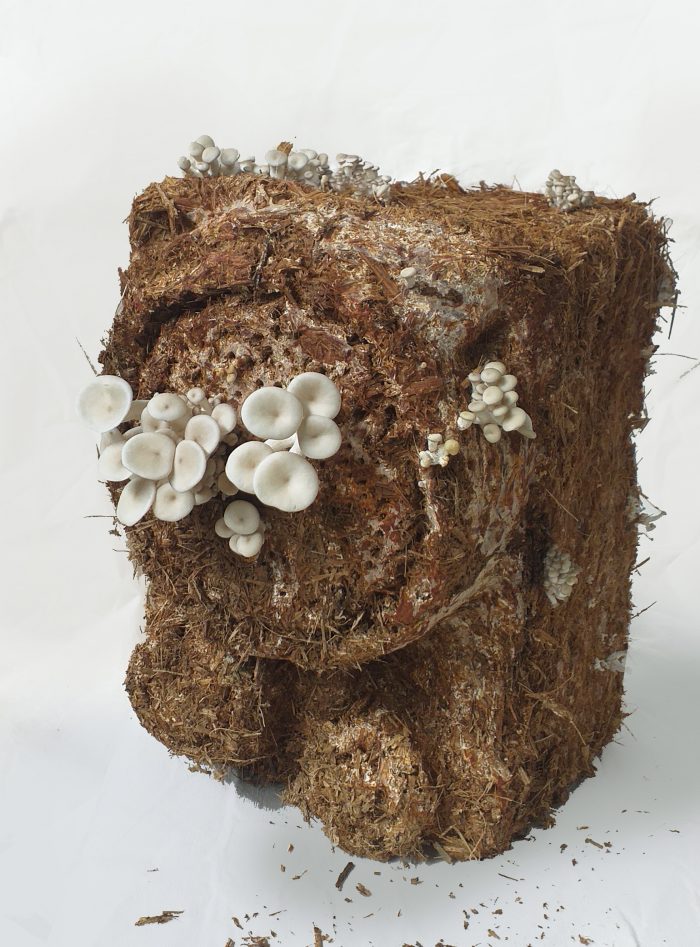
16.07.2020
Through a review of three projects carried out at the MAC Lima before the confinement, curator Giuliana Vidarte reveals the effects that the pandemic has had on the environment and how the exhibition space can revitalize our links with the non-human.

Water, (Magic) Earth, and Fungi: On Three Exhibition Projects at MAC Lima
Thanks to Lima’s humid climate and its location right at the center of a coastal desert, water, earth, and fungi are protagonists in the daily lives of the city’s inhabitants. We breathe water and we live among clouds of dust, with fungi growing on the surfaces of everything. However, like in other large capitals of the world, the relationships between the elements and the organisms of Lima’s ecosystem have been seriously damaged. This Lima of fungi, water, and earth is the eighth-most polluted city in Latin America and, furthermore, Peru is the third country most vulnerable to the effects of climate change.
In the first weeks of social isolation mandated by the Peruvian government, several news reports highlighting the clean waters of the Rímac River, which supplies 30 percent of Lima’s population with water, and the general transformation of natural spaces in the city went viral on social media. These changes were a consequence of the city’s inhabitants’ confinement at home and the reduction in the amount of waste being dumped into the riverbed. In those same days, images showing dolphins swimming in the waters of the Rímac surfaced.[1] The legendary colorful river dolphins, or the pink dolphins of the Amazon River, appeared jumping and seemed to be playing with a person. In order to reach this subject and play with them, however, the dolphins would have had to achieve the unthinkable feat of crossing the Andes. A few hours later, the information was proven false: the photographs had been doctored.
Nonetheless, the news reporting cleaner river waters as a result of the pandemic makes evident the negative impact humans have had on nature and our capacity to alter Earth and its life forms. The doctored photographs emphasize the idealization of this supposedly great transformation that we are currently experiencing; they established an impossible bond between the human and nonhuman, a new ecosystem re-established with the river’s clear waters and the river dolphins.

In the Amazonian regions of Peru, where the pink Rímac dolphins originate, indigenous communities have safeguarded a knowledge that focuses on the human connection to the nonhuman. They recognize that plants and animals have spirits and that we must know how to listen to them. This point of view reflects the diverse understandings of the relationship between the concepts of humanity and nature, or culture and nature, that exist in the Amazon. The very fluid connections between these apparent—and supposedly opposing—identities demonstrate a particular capacity for coexistence with “other” beings, which is an important part of the invaluable knowledge of the Amazonian communities. However, today it is impossible to hear and share this knowledge in the same way as in previous generations, for the dialogue between all these beings has been disturbed by the pollution and destruction of the natural environment.
The Museum of Contemporary Art in Lima is located in the district of Barranco, one of the most humid and representative of the coastal strips of the city. In December 2018, I began working at the MAC Lima as part of a team that proposed a program reflecting new curatorial and research approaches focusing on contemporary Peruvian artistic practices. In the last months, between late 2019 and early 2020, we organized an exhibition program that aimed to develop collective projects in collaboration with various groups of Peruvian artists. Many of these proposals involved installations that generated spaces where it was possible to establish links with the museum’s audiences and to create and share ideas and thoughts. We consider it fundamentally important that the museum is affirmed as a space for continuous creation, one which allows us to experiment with installations and, through them, to think about how we relate to our surroundings, as well as about the current problems in Peru and the world—including pollution, deforestation, and environmental crisis—in order to contribute to the creation of a sustainable global culture.
Drawing from this experience, I will review three of the latest projects we developed at MAC Lima. Two of these exhibitions had already opened and one was still in production when the building closed due to the pandemic. These projects include Ecosistema del agua [The Ecosystem of Water], which ran from June to September 2019 in Room 3; Materia Común [Common Matter], which opened in October 2019 and is still up in Room 3, although it is no longer open to the public; and Desbosque: desenterrando señales [Unforest: Unearthing Signs], whose production was suspended, but which we hope to be able to open very soon in Room 1. Several common elements run through these three projects. Developed during a time when MAC Lima was in the process of reaffirming its links to its community, all three proposals explore the ways in which we connect to, communicate with, and understand the spaces in which we live. All of the projects’ organizers approached this question with a keen understanding of the reciprocal relationship between humans and their nonhuman environment. All three exhibitions took a natural element, such as water or earth, or organisms like fungi—all of which function as the substrates or binding materials for other elements, and whose protection and valuation is imperative in the midst of the current environmental crisis—as their starting point, linking them to conceptual particularities within each proposal.

Furthermore, the three installations address issues like the relationship between human beings and the environment, the landscape, and other living beings. In the current pandemic setting, in which these interactions have changed dramatically, it is possible and necessary to rethink these artistic proposals. The projects highlight the limitations of the human understanding of nature and propose such questions as: What can we learn from what we call nature? How can we build on it? How do we create knowledge in the context of climate change? How do we contribute to the destruction of the natural environment? How do we engage with the nonhuman? Each project also constitutes an interdisciplinary research proposal that draws on knowledge from antiquity, pre-Columbian communities of the past, magical thinking about the earth, and the “intelligence” of plants. By listening to nature–the water, the earth, and fungi–these projects aim to broaden our vision of human supremacy and to establish valid doubts about the ways in which we have been relating and interacting with our natural environment
Ecosistema del agua was the recipient of the First MAC Lima Prize for Art and Innovation, 2019. The installation was designed by Ana Teresa Barboza and Rafael Freyre together with Roberto Román (stone work), Samuel Goicochea, Eber Goicochea, and David Goicochea (reed and totora weaving), Elizabeth Vásquez (ceramics), and Erick Malásquez (adobe work). The proposal replicated the water cycle, recovering knowledge that the societies of ancient Peru acquired from their study of this system. The piece included materials such as reeds and cattails, as well as phyto-purifying plants typical of the wetlands along the Peruvian coast. The installation then proposed an experiment with the phenomenon of water collection and onsite purification. At the end of the tour, the visitor was invited to drink the water that had been filtered in the installation, thus integrating themselves into the ecosystem as one more step in the water’s journey. As part of the production of the show, mats made of reed and totora fibers were woven over the course of several months at the museum. When the show opened, visitors were allowed to walk on top of the finished surfaces while the fibers captured water and continued the cycle.
This installation opened up the possibility of recognizing the relations that exist between humans and ecosystems, especially those of the Peruvian coastal wetlands. The piece examined several different perspectives on this relationship, from the ancestral knowledge of the uses of water and its systems to the scientific understanding of the water cycle, as well as ritual connections with water, which the show activated by offering viewers the possibility of drinking within the tour. By integrating human beings into the cycle, the installation’s organizers made evident how humans continuously participate in the natural transformations of the environment and helped to convey an understanding that these transformations are not phenomena which we simply observe from the outside, but rather are phenomena of which we form an integral part and which are directly linked to our way of life.

On the other hand, Materia Común, designed by the artists Ximena Garrido-Lecca and Ishmael Randall Weeks and curated by Jose Falconi, was proposed as an installation to be built directly in Room 3 of the museum. The project’s main structure was inspired by The City of the Sun, a utopian design for a city in which all knowledge could be gathered, proposed by the Dominican friar Tommaso Campanella in the early seventeenth century. The artists proposed that the installation be made using earth—some of it, the magic black earth from the Chilca region to the south of Lima—for stucco walls and using the different local newspapers delivered to the museum every day. The visitors were invited to participate in the preparation of the paper that was to be included in the installation’s structures, or to read the newspapers aloud to those who were working on the installation. This narrative component accompanying the construction was inspired by the readers in tobacco shops in Cuba, who are in charge of reading to the workers making cigars with tobacco leaves.
In addition, visitors were invited to bring objects as offerings to raise the stucco walls, contribute to a common project, and discuss how contemporary knowledge is built, what role the media plays, and how we currently share that information. The public collaborated with all kinds of offerings, from identity documents and money from other countries to personal photographs, poems, or letters dedicated to the project itself. We followed the building of the project every step of the way, we saw how the walls were raised, we listened to the readers, and we shared with the artists, museum mediators, and the public commenting on the new and fabulous objects that arrived as offerings along with the daily newspapers. The installation thus opened up questions about our capacity to forge “common matter” between a wide group of people and, along the way, made clear that we belong to an existing network, a constant cycle of exchange that is reflected in its own materiality. We build everything on earth and with the earth. Our presence, daily exchanges, objects, and ideas also mark that land—a structure made of human and nonhuman matter—written texts, earth, voices, images, and thoughts generated through narration—that account for an integral whole.
For its part, the bio-installation Desbosque: desenterrando señales, created by FIBRA Colectivo–made up of Gabriela Flores, Lucía Monge, and Gianine Tabja—which chose to work with oyster fungi, proposes to generate a space in which humans can experience the intensity and extent of the deforestation of the Amazon through light and sound stimuli. As I already mentioned, this exhibition was being set up in Room 1 of the museum and we are waiting to continue its production and to receive visitors. The sculptures which form part of the installation are made of mycelia, the vegetative part of fungi which gives it structure and whose branches, like the roots of the trees, make up mycorrhizal networks, which connect the fungi together in an underground system. For the work, the fungal bodies leave the ground and are placed in front of the spectators in the form of human objects of communication: telephones, microphones, speakers, and radios. In this way, they affirm the need to rethink the way we create the networks that connect us as living beings and which, already weakened, have generated a serious crisis.

Desbosque thus emerges with the intention of learning from nonhuman knowledge and technologies; it works with fungi to render visible the loss of the trees visible through the replication of human artifacts. The installation proposes another way of experiencing the information, data, or figures that we are used to receiving but that no longer mobilize us. Alerts and biotechnology make up a system that represents the pace of deforestation, facilitating a reflection on the problems that arise from human disagreements. The idea is to present the internal components of the forest and to present fungi, trees, and underground networks as models for communication and generating connections in order to recognize these organisms that maintain the solid connections which make life possible on this planet we all share.
These three exhibitions propose the creation of spaces that can help us to think collectively about the links between the human and the nonhuman, the consequences of human intervention on the environment, and our ability to learn from nature and to build and create together. They are spaces where we can share our points of view, weave, build, and grow, where we can think through experience and reaffirm it as an instrument of knowledge. In the current pandemic scenario, the MAC Lima has had the opportunity to rethink these projects and to recognize the importance of “listening” to the natural elements at the core of these three exhibitions in order to consolidate itself as a productive substratum, a space that strengthens connections and affirms relationships, that establishes networks, fluid as water, solid and fertile as (magic) earth, and capable of transmitting knowledge, communicating, and connecting other elements together, as fungi already do.
Very soon in the Lima of fungi, water, and earth, we will return to the museums. We hope it will be an opportunity to consolidate them as spaces in which the links between humans and nonhumans can be rethought and from which new forms of coexistence, exchange, and learning can be projected.
—
Notes
[1] The photographs can be viewed here: https://larepublica.pe/verificador/2020/04/25/delfines-rosados-en-el-rio-rimac-imagenes-son-falsas-y-se-trata-de-fotomontajes-en-redes-sociales/
Las fotografías se pueden revisar en este portal web
Comments
There are no coments available.